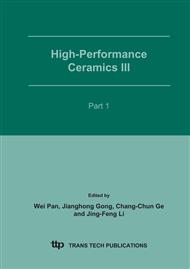p.1057
p.1061
p.1065
p.1069
p.1075
p.1079
p.1083
p.1087
p.1089
Cordierite-CeO2 Composite Ceramic: A Novel Catalytic Support Material for Purification of Vehicle Exhausts
Abstract:
Stable oxygen concentration in exhausts is a decisive factor in catalytic purification of the vehicle exhausts. Nanostructured CeO2 is generally added into catalytic coating on a ceramic support to adjust the oxygen concentration because it possesses a unique oxygen storage capacity (OSC). However, a small amount of CeO2 gets insufficient when the oxygen concentration fluctuates in a large range. In the present work, the cordierite-CeO2 composite ceramic with oxygen storage capacity was prepared for a support material of catalytic converters. The oxygen storage-release performance of the ceramics, including temperature of releasing oxygen, adsorption process of oxygen and the oxygen storage, was examined by a temperature-programmed gas chromatography. The composition of the ceramics was analyzed by an X-ray powder diffraction (XRD) and a scanning electron microscope (SEM) to validate the reliability of the ceramic as the support material with OSC. Results show that the ceramics consist of α-cordierite and CeO2 phases, the latter of which is uniformly dispersed throughout the cordierite matrix. The ceramic powder with 10-20wt% of CeO2 possesses the expected oxygen storage capacity. It is suggested that this novel cordierite-CeO2 composite ceramic is helpful of improving the purification effect of vehicle exhausts.
Info:
Periodical:
Pages:
1075-1078
Citation:
Online since:
February 2007
Authors:
Keywords:
Price:
Сopyright:
© 2005 Trans Tech Publications Ltd. All Rights Reserved
Share:
Citation:


